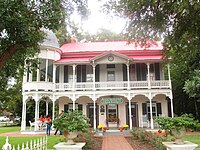
Yiddish is a West Germanic language historically spoken by Ashkenazi Jews. It originates from 9th century Central Europe, providing the nascent Ashkenazi community with a vernacular based on High German fused with many elements taken from Hebrew and to some extent Aramaic. Most varieties of Yiddish include elements of Slavic languages and the vocabulary contains traces of Romance languages. Yiddish has traditionally been written using the Hebrew alphabet; however, there are variations, including the standardized YIVO orthography that employs the Latin alphabet.

The United States does not have an official language at the federal level, but the most commonly used language is English, which is the de facto national language. In addition, 32 U.S. states out of 50 and all five U.S. territories have declared English as an official language. The great majority of the U.S. population speaks only English at home. The remainder of the population speaks many other languages at home, most notably Spanish, according to the American Community Survey (ACS) of the U.S. Census Bureau; others include indigenous languages originally spoken by Native Americans, Alaska Natives, Native Hawaiians, and native populations in the U.S. unincorporated territories. Other languages were brought in by people from Europe, Africa, Asia, other parts of the Americas, and Oceania, including multiple dialects, creole languages, pidgin languages, and sign languages originating in what is now the United States. Interlingua, an international auxiliary language, was also created in the U.S.

Kendall County is a county located on the Edwards Plateau in the U.S. state of Texas. In 2020 census, its population was 44,279. Its county seat is Boerne. The county is named for George Wilkins Kendall, a journalist and Mexican–American War correspondent.
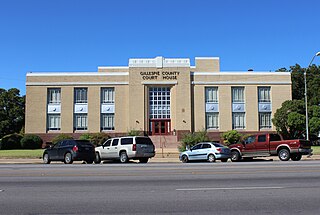
Gillespie County is a county located on the Edwards Plateau in the U.S. state of Texas. As of the 2020 census, its population was 26,725. The county seat is Fredericksburg. It is located in the heart of the rural Texas Hill Country in Central Texas. Gillespie is named for Robert Addison Gillespie, a soldier in the Mexican–American War.

Fredericksburg is a city in and the seat of Gillespie County, Texas, United States. As of the 2010 Census, this city had a population of 10,530.

Boerne is a city in and the county seat of Kendall County, Texas, United States, in the Texas Hill Country. Boerne is known for its German-Texan history, named in honor of German author and satirist Ludwig Börne by the German Founders of the town. The population of Boerne was 10,471 at the 2010 census, and in 2020 the population was 17,850. The city is noted for the landmark U.S. Supreme Court case City of Boerne v. Flores. Founded in 1849 as "Tusculum", the name was changed to "Boerne" when the town was platted in 1852.

Over 50 million Americans claim German ancestry, which makes them the largest single claimed ancestry group in the United States. Around 1.06 million people in the United States speak the German language at home. It is the second most spoken language in North Dakota and is the third most spoken language in 16 other states.
This article details the geographical distribution of speakers of the German language, regardless of the legislative status within the countries where it is spoken. In addition to the Germanosphere in Europe, German-speaking minorities are present in many other countries and on all six inhabited continents.

The Guadalupe River runs from Kerr County, Texas, to San Antonio Bay on the Gulf of Mexico, with an average temperature of 17.75 degrees Celsius. It is a popular destination for rafting, fly fishing, and canoeing. Larger cities along it include Kerrville, New Braunfels, Seguin, Gonzales, Cuero, and Victoria. It has several dams along its length, the most notable of which, Canyon Dam, forms Canyon Lake northwest of New Braunfels.

Wakashan is a family of languages spoken in British Columbia around and on Vancouver Island, and in the northwestern corner of the Olympic Peninsula of Washington state, on the south side of the Strait of Juan de Fuca.
Dialectology is the scientific study of linguistic dialect. In the 19th century a branch of historical linguistics, dialectology is today by some considered a sub-field of sociolinguistics. It studies variations in language based primarily on geographic distribution and their associated features. Dialectology deals with such topics as divergence of two local dialects from a common ancestor and synchronic variation.

Serrano is a language in the Serran branch of the Uto-Aztecan family spoken by the Serrano people of Southern California. The language is closely related to Tongva, Tataviam, Kitanemuk and Vanyume. Serrano has free word order with the only rule being that verbs usually come last.
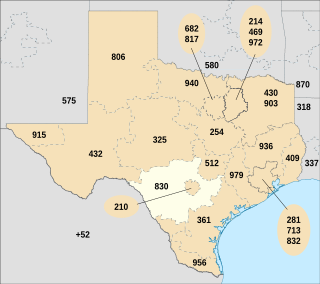
Area code 830 is the telephone area code in the North American Numbering Plan (NANP) for the Texas Hill Country and most of San Antonio's suburbs. It completely surrounds area codes 210 and 726, which serve most of San Antonio itself along with its innermost suburbs.
Of the languages spoken in Texas none has been designated the official language. As of 2020, 64.9 % of residents spoke only English at home, while 28.8% spoke Spanish at home. Throughout the history of Texas, English and Spanish have at one time or another been the primary dominant language used by government officials, with German recognized as a minority language from statehood until the first world war. Prior to European colonization, several indigenous languages were spoken in what is now Texas, including Caddoan, Na-Dené and Uto-Aztecan languages.

Texas Germans are descendants of Germans who settled in Texas since the 1830s. The arriving Germans tended to cluster in ethnic enclaves; the majority settled in a broad, fragmented belt across the south-central part of the state, where many became farmers. As of 1990, about three million Texans considered themselves German in ancestry.
Texan English is the array of American English dialects spoken in Texas, primarily falling under Southern U.S. English. As one nationwide study states, the typical Texan accent is a "Southern accent with a twist". The "twist" refers to inland Southern U.S., older coastal Southern U.S., and South Midland U.S. accents mixing together, due to Texas's settlement history, as well as some lexical (vocabulary) influences from Mexican Spanish. In fact, there is no single accent that covers all of Texas and few dialect features are unique to Texas alone. The newest and most innovative Southern U.S. accent features are best reported in Lubbock, Odessa, somewhat Houston and variably Dallas, though general features of this same dialect are found throughout the state, with several exceptions: Abilene and somewhat Austin, Corpus Christi, and El Paso appear to align more with Midland U.S. accents than Southern ones.

Wrede School is located at 3929 S. State Highway 16, Fredericksburg, Gillespie County, Texas. It was first built in 1896. The school district was consolidated with Fredericksburg Independent School District in 1960. The schoolhouse now serves as a community center. It was added to the National Register of Historic Places in Texas on June 1, 2005.
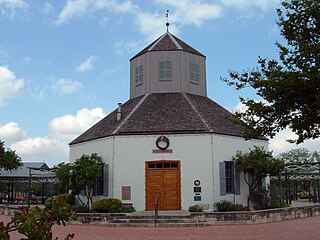
The History of Fredericksburg, Texas dates back to its founding in 1846. It was named after Prince Frederick of Prussia. Fredericksburg is also notable as the home of Texas German, a dialect spoken by the first generations of German settlers who initially refused to learn English. Fredericksburg shares many cultural characteristics with New Braunfels, which had been established by Prince Carl of Solms-Braunfels the previous year.
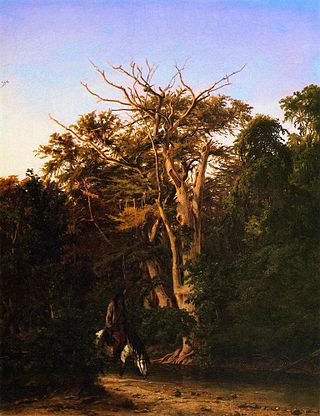
The Pinta Trail is a historic trail in Central Texas that was first traveled by indigenous tribes, and later explorers, settlers, soldiers, and travelers. The 19th-century Germans who settled the Texas Hill Country used part of the Pinta Trail on their journey northward from New Braunfels to found Fredericksburg. A historic battle between a Texas Rangers patrol and a band of Comanches is often said to have occurred near a ford where the Pinta Trail crossed the Guadalupe River.
The Russian language is among the top fifteen most spoken languages in the United States, and is one of the most spoken Slavic and European languages in the country. Since the dissolution of the Soviet Union, many Russians have migrated to the United States and brought the language with them. Most Russian speakers in the United States today are Russian Jews. According to the 2010 United States Census the number of Russian speakers was 854,955, which made Russian the 12th most spoken language in the country.
